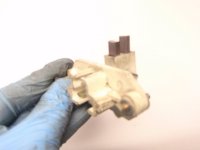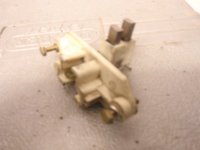How much amperage do I need? The alternator that was provided with your vehicle should handle all of its electrical needs as outfitted from the factory. If you have added electrical components such as stereo amps, lights, compressors, winch, plow, etc. then you will need to produce more power to operate these components. Use our
Amperage Load Calculator to find out how much power you now need from an upgraded alternator.
Why does my new alternator have a smaller pulley?
Alternators produce more amperage the faster they spin up to their maximum capacity. Most people need the best output they can get at low speed. When the engine is idling, the alternator will not produce as much power because it is turning slower. In order to boost output at lower RPM, it is beneficial to spin the alternator faster by using a slightly smaller pulley to accomplish this. In most cases you should be able to use the alternator with the smaller pulley without having to use a smaller belt. Check to make sure that your belt is not worn, stretched, or that the tensioner has the correct amount of tension to keep the belt from slipping or having too much tension.
Why is output so low at idle?
1) Too much load - The amount of load (components using power) may be too much for the amount of output the alternator is capable of producing at that slower speed. Check the amperage output at the rear of the alternator and see if it is more or less than the amperage coming out of the battery’s positive cable. If increasing the RPM of the engine slightly causes the alternator to exceed the requirements, then it may be necessary to use a higher rated alternator, raise the engine idle speed (if possible), or change to a smaller diameter pulley to increase output at that RPM,.
2) Idle Speed - Some newer vehicles have idle speeds much lower than earlier models. This is done to help the fuel economy. On these vehicles the use of a smaller diameter pulley is almost a necessity to get low RPM output to an acceptable level. You may find that at times the load demand may be greater than the available output of the alternator. There is no problem with having this condition for short periods such as heavy bass hits from the stereo. Using an auxiliary battery to add additional reserve capacity can help alleviate problems stemming from these circumstances.
3) Pulley ratio – In order for the alternator to spin fast enough to produce the power necessary at low RPM, the pulley ratio should be correct. Changing the crankshaft pulley or alternator pulley will vary this ratio. For most vehicles the ratio should be at least 3:1. See the question “What is pulley ratio” to find out how to calculate this.
4) Wiring – When upgrading to a high output alternator it is important to make sure that the power can get to where it needs to go. The factory charge cable and ground cables were designed to handle only as much amperage as the stock alternator could provide. Using a higher amperage alternator, you need to upgrade the charge cable to handle the higher current that will be passing through or the power will be restricted. It is also necessary to upgrade the ground side as well. This would include the battery to frame, body, and engine block.
Can I use underdrive power pulleys?
The use of underdrive pulleys for the crankshaft has become popular but it has the downside of slowing alternator RPM. This will cause the alternator to have lower output at slow speeds. We recommend that the factory sized crankshaft pulley be used whenever you upgrade to a high output alternator.
Will a higher amperage alternator cause any problems with my stock electrical system?
A higher amperage alternator will not pose any problems to the vehicle’s electrical system. Amperage will flow to only those components that can use the energy and supply as much amperage as the component can consume. For example, you may have a 100 amp alternator in your vehicle and the turn signals have small wiring and will only use 10 amp of power. Upgrading to a 200 amp alternator will not affect these components. On externally regulated alternators you can still use the stock factory regulator. Of course you need to get the power to where it needs to go, so see the next question about modifications.
What modifications will I need to make when upgrading to a high amp alternator?
Almost all of the alternators we sell are meant to be a direct replacement for your factory alternator so you should not have to modify the installation. You should, however, upgrade the alternator’s charging cable and ground cables (battery to frame, body, and engine block) so that you can get the power to where it can be used. A smaller diameter alternator pulley is usually included with the alternator we provide and in rare instances a slightly shorter belt may be necessary.
What does the rated output of your alternators mean?
Our alternators are tested on our test bench to provide the best output for most driving conditions including low speed or idle operation. The specifications you see on our website reflect results as follows:
Advertised Idle Output @ 2,400 RPM
Advertised Maximum Output @ 4,800 – 5,200 RPM
These figures are alternator RPM speed. In order to calculate the corresponding engine RPM you must divide those numbers by your pulley ratio. To calculate pulley ratio, see the next question.
What is pulley ratio?
Pulley ratio is the comparison of the crankshaft pulley diameter to the alternator pulley diameter. In order to get your pulley ratio you would measure the diameter of your crankshaft pulley and divide it by the diameter of the alternator pulley you will be using. For example, if your crankshaft pulley is 6” in diameter and the alternator pulley is 2” in diameter, the ratio would be 3:1 or 6 ÷ 2 = 3. The larger the ratio, the faster the alternator will spin.
CLICK HERE to go to our pulley ratio chart.
Will a high output alternator have a shorter lifespan?
The high output alternators we design should be able to provide a long life. However, the more current that is produced by an alternator, the faster the brushes may wear. If you are using an alternator more toward its peak capacity it will tend to use more brush material. Luckily, replacing brushes on most alternators is relatively easy and very inexpensive. Even if you are running the alternator at peak capacity it should provide you with years of good use before you may need to do any maintenance.
http://www.qualitypowerauto.com/pages/AlternatorFAQ.php


